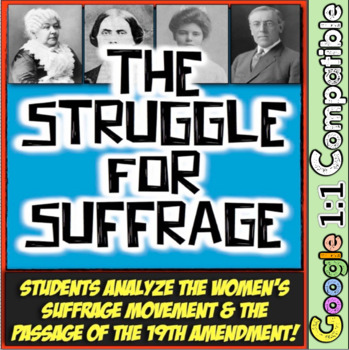Women's Suffrage Activity From Seneca Falls to the 19th Amendment
- Zip
- Google Apps™

What educators are saying
Description
In this Women's Suffrage and 19th amendment primary source-based resource on the Women's Suffrage Movement, students analyze the struggle for women's voting rights from the Seneca Falls Convention to the passage of the 19th Amendment. Students also learn the roles of several key figures, including Alice Paul, Susan B Anthony, Lucretia Mott, Elizabeth Cady Stanton, and President Woodrow Wilson.
This lesson is included in BOTH the Progressive Era (Gilded Age) Bundle and my Roaring '20s and 1930s Bundle!
Students analyze a variety of primary and secondary sources as they learn about the progression of women's struggle to gain the right to vote. Students will learn about, among many things, the contributions of Lucretia Mott, Susan B Anthony, Elizabeth Cady Stanton, Alice Paul, and Woodrow Wilson. In addition to this, students will also understand the origin of the Women's Rights Movement, the protests and arrests of Susan B Antony and Alice Paul, the role of President Woodrow Wilson, why people argued for and against women's suffrage, how it was debated in Congress, and how it was reported to the public in local newspapers. Students will use both primary and secondary sources to draw conclusions and make inferences regarding the struggle for women to gain the right to vote.
Students use the included source guide as they analyze the ten sources, then compile their learning by creating a graphic novel from the template included!
A Google 1:1 compatible version is included in this product! Use in either a traditional setting or in the 1:1 environment!
A full key is included --- Enjoy!
Be sure to follow the History with Mr E Facebook page, and don't forget to signup for the Social Studies Newsletter to receive information on flash sales, product releases, and classroom tips!
----
Check out these other great resources on the Progressive Era & Gilded Age!
Women's Suffrage: The Struggle for Suffrage from Seneca Falls to 19th Amendment!
Civil Rights & Emma Lazarus in Progressive Era! Dawes Act & Chinese Exclusion!
Progressive Era Problems: Why Did Mark Twain Name It The Gilded Age? Engaging!
John D Rockefeller: Hero or Villain? Where does Rockefeller fit in Gilded Age?
Muckraker Magazine Project! Students investigate the work of Gilded Age Reformers!
Tammany Hall Investigation: What Was It? How Did Tammany Work? Was it Wrong?
Theodore Roosevelt's New Nationalism: Analyze & Write Roosevelt A Letter!
----
***ATTENTION DISTRICTS AND DEPARTMENTS*** If you are purchasing for your school's department, please buy the appropriate amount of licenses. If it is purchased with school funds, it belongs to the school. If you are a large school district and you are interested in a full district license, please message me and I can work out a quote that is cheaper than what you see.





